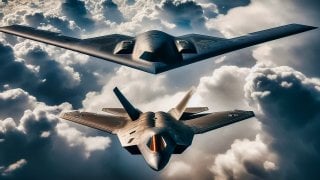B-21 Raider: Does America Really Need This Expensive Stealth Bomber?
Although it’s been a generation since America updated her bomber fleet, the cost of the B-21 program, plus the secrecy of the program, has inspired questions, like, does America need a new bomber?
Last Month, the forthcoming B-21 Raider took its maiden test flight. The B-21 program is still shrouded in secrecy – but the test flight marks a tangible step forward for the much-anticipated stealth bomber.
“The B-21 Raider is in flight testing,” said Ann Stefanek, an Air Force spokeswoman. The testing is an important step toward providing “survivable, long-range, penetrating strike capabilities to deter aggression and strategic attacks against the United States, allies, and partners,” Stefanik added.
When the B-21 joins the fleet, the flying wing aircraft will be the first new American bomber produced in more than three decades. Although it’s been a generation since America updated her bomber fleet, the cost of the B-21 program, plus the secrecy of the program, has inspired questions, like, does America need a new bomber?
Does America Need the B-21 Raider?
The question is valid.
America has, with a significant margin, the highest defense spending of any nation on Earth. The premise of developing and procuring new military technologies is always going to raise questions from a war-weary populace who has watched remarkable amounts of their tax base go straight to Raytheon, Lockheed Martin, and in the case of the B-21, Northrup Grumman.
And America already has a formidable bomber fleet. The B-52 has been in service for seventy years and is slated to serve for another thirty. The B-1 Lancer is still a capable, swept-wing bomb truck. And the B-2 Spirit was the world’s first stealth bomber. Actually, the B-2 is still the world’s only stealth bomber.
So, why does America need a new stealth bomber – one that happens to look like a carbon copy of the B-2.
The Case for the B-21 Raider
Retired Air Force Colonel Mark Gunzinger argues that America does in fact need the B-21 – in order to deter conventional and nuclear conflicts.
“The ability to conduct long-range strikes at scale in all threat environments has been a decisive U.S. military advantage for more than 70 years,” Gunzinger wrote. “Long-range bombers enable theater commanders to strike enemy targets inaccessible to other U.S. and allied forces.”
Yes, but doesn’t the US already have long-range bombers?
Gunzinger argues that America’s current bomber force is too small, and that “the U.S. will need a significantly larger bomber force than it has today.” Because, “without the Raider, the U.S. has no viable “Plan B.””
“To achieve the capacity to simultaneously defeat Chinese aggression in the Indo-Pacific, credibly deter an opportunistic aggressor in a second theater, and still deter nuclear attacks on the United States – all requirements off the 2022 National Defense Strategy (NDS) – the U.S. will need a significantly larger bomber force than it has today.”
Could the US not mitigate a bomber gap, and provide nuclear deterrence, with the other two poles in the nuclear triad – intercontinental ballistic missiles and ballistic missile submarines?
Gunzinger argues that bombers are a cheaper option than ICBMS or submarines. Yet, even assuming you accept Gunzinger’s argument that the US bomber force needs to be bigger, the question becomes, do we need the B-21? Or could the US produce more of the cheaper B-52 and B-1 airframes? No, according to Gunzinger, because the B-52 and B-1 are not capable of penetrating protected airspace.
Gunzinger continues, explaining that in 1989, the Air Force had 411 bombers – enough to “deter nuclear threats and fight conventional conflicts against Cold War adversaries including the Soviet Union.” Gunzinger adds that the 411-bomber-strong force “enabled the decisive response that defeated Iraqi forces and sent them fleeing back home from occupied Kuwait in 1991. I don’t doubt that a 411-bomber-fleet was enough to deter Cold War adversaries – but could Cold War adversaries have been deterred even if the US had possessed a smaller bomber fleet? And how about Iraq? Could Saddam’s forces not have been expelled from Kuwait even if the US had possessed a smaller bomber fleet?
Gunzinger laments that thirty years of budget cuts has left the US Air Force with just 141 bombers – most of which are the non-stealth B-52s and B-1s.
“DOD’s only long-range strike aircraft capable of penetrating contested areas protected by advanced integrated air defense systems (IADS) are its 20 B-2 bombers,” Gunzinger wrote. “Yet even that number is an overstatement: Only 16 of the 20 B-2s are assigned to combat squadrons…Further it is likely in any conflict that some nuclear-capable B-2s would be withheld from deployment to deter nuclear attacks on the U.S. homeland.”
“In short,” Gunzinger wrote, “DOD’s long-range penetrating strike capacity for a conflict with China currently totals just six to eight B-2 sorties per day.”
Gunzinger continued, making a compelling argument that the US needs long-range penetrating bombers – especially in a conflict with China. “A total force of more than 300 bombers including 225 stealthy aircraft is needed to provide the penetrating strike capacity needed to defeat peer aggression,” Gunzinger concluded.
About the Author
Harrison Kass is a prolific defense writer with over 1,000 published pieces. An attorney, pilot, guitarist, and minor pro hockey player, Harrison joined the US Air Force as a Pilot Trainee but was medically discharged. Harrison holds a BA from Lake Forest College, a JD from the University of Oregon, and an MA from New York University. Harrison listens to Dokken.


